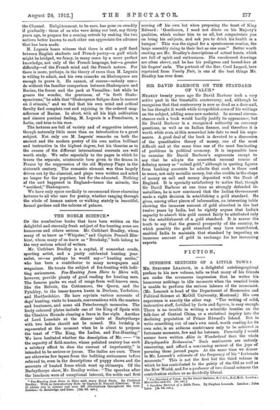SIR DAVID BARBOUR ON THE STANDARD OF VALUE.*
NEARLY twenty years ago Sir David Barbour took a very active part in the bimetallic controversy, and, although he recognizes that that controversy is now as dead as a door-nail, he has thought it worth while to republish some of his writings on the subject, adding some new material. In normal circum- stances such a book would hardly justify its appearance, but Sir David Barbour is a recognized authority on currency questions, as well as on Indian finance, and therefore it is worth while even at this somewhat late date to read his argu- ments. A good deal of the book is devoted to a discussion of the quantitative theory of money, one of the most difficult and at the same time one of the most fascinating of problems in political economy. It is impossible here to examine Sir David Barbour's arguments except to say that he adopts the somewhat unusual course of defining money as " coined gold," although in quoting figures from banking accounts he admits that cash is there used to mean, not only metallic money, but also credits in the shape of money on call and money deposited with the Bank of England. It is specially satisfactory to notice that, though Sir David Barbour at one time so strongly defended bi- metallism, he is now convinced that the Indian Government made a right decision in establishing a gold standard. He gives, among other pieces of information, an interesting table showing the immense amount of gold absorbed in the last twelve years by India, but he rightly argues that India's capacity to absorb this gold cannot fairly be attributed only to the establishment of a gold standard. It is nearer the truth to say that the general prosperity of the country, to which possibly the gold standard may have contributed, enabled India to maintain that standard by importing an immense amount of gold in exchange for her increasing exports.


































 Previous page
Previous page